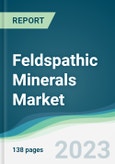The feldspathic minerals market was valued at US$1,948.459 million in 2021.
Feldspathic minerals are a group of rock-forming minerals primarily composed of aluminum silicates and other elements such as sodium, potassium, and calcium. They are among the most abundant minerals in the Earth's crust, making up about 60% of its composition by weight. This means that feldspathic minerals are extremely common and can be found in various geological settings, including igneous, metamorphic, and sedimentary rocks. The most common feldspathic minerals are orthoclase, plagioclase, and microcline. They are essential components of many types of rocks, including granite, gneiss, syenite, and pegmatite. They are typically characterized by their hardness, high melting points, and distinctive cleavage patterns. Feldspathic minerals are commonly found in rocks, soils, and other geological materials. These minerals are primarily composed of aluminum, silicon, and oxygen and can also contain other elements such as potassium, sodium, and calcium. They are widely used in various industries, including construction, ceramics, glass manufacturing, and electronics.
Additionally, feldspathic minerals are used to produce ceramic tiles, sanitary ware, glass, and other building materials. The demand for these products is rising due to the increasing construction activities in developing economies, such as China, India, and Brazil. These minerals are also used as a fluxing agent in ceramics production, which helps reduce the melting point of clay and other ceramic materials. The glass industry is also a major consumer of feldspathic minerals. These minerals are used as raw materials in glass production because it enhance the toughness and durability of glass, especially in the manufacture of clear and colored glasses.
Market Drivers:
- Increasing demand from the construction and ceramics industries
The increasing demand from the construction and ceramic industries is mainly driving the growth of the feldspathic minerals market. Due to their unique physical and chemical properties, feldspathic minerals are essential in cement, concrete, and ceramic products. In the construction industry, feldspathic minerals are primarily used as an additive in cement and concrete mixes. These minerals help to enhance the strength and durability of the resulting building materials and improve their resistance to weathering and erosion. Additionally, feldspathic minerals can also be used as a decorative component in concrete, providing a range of colors and textures that can be used to create visually appealing architectural features. By adding feldspathic minerals to ceramic formulations, manufacturers can produce stronger, more durable, and more resistant to scratches and other forms of damage.
- Glass manufacturing sector
Feldspathic minerals play a very crucial role in the production of glass, particularly soda-lime glass, borosilicate glass, and aluminosilicate glass. In the glass manufacturing process, feldspathic minerals are primarily used as a flux, which helps lower the glass mixture's melting point. By adding feldspathic minerals to the glass mixture, manufacturers can reduce the energy required to melt the raw materials, resulting in cost savings and increased efficiency. Soda-lime glass, the most commonly used type of glass, is made by combining silica sand, soda ash, and limestone with feldspathic minerals. The resulting glass is used in various applications, including windows, bottles, and tableware. In recent years, the demand for soda-lime glass has grown significantly, particularly in the automotive sectors, which has driven the demand for feldspathic minerals.
Market Developments:
- In May 2020, Turkish feldspar floatation innovations Arkema-Armaaz was featured in the May issue of International Mining magazine, highlighting its innovative Joint Collector Development Program (JCDP).
Asia- Pacific to show robust growth over the forecast period. The Asia-Pacific (APAC) region is expected to witness the highest growth in the feldspathic minerals market in the forecast period. Countries such as China, India, and Japan are at the forefront of urbanization and industrialization, which has increased demand for feldspathic minerals, particularly in the construction and ceramics industries, which are key end-use industries for these minerals. The Asia-Pacific region has a large and growing population, driving demand for consumer goods like glass products and tableware. Feldspathic minerals are essential in producing these goods, and as demand for them grows, so does the demand for feldspathic minerals. Also, there has been a significant increase in infrastructure investment in the Asia-Pacific region, particularly in countries such as China, which is driving demand for construction materials, including feldspathic minerals. The Chinese government's "Belt and Road Initiative," which aims to create a modern-day Silk Road connecting China with Europe, Asia, and Africa, is expected further to drive demand for feldspathic minerals in the region.
North America accounts for a notable share of the feldspathic minerals market. The growth of the feldspathic minerals market in this region is expected to continue in the forecast period, driven by a rapidly growing population, which has led to an increase in demand for products such as glass and ceramics. Feldspathic minerals are used in various applications, such as automotive interiors, which have increased demand.
Market Segmentation:
By APPLICATION
- Ceramic
- Glass
- Fillers
- Others
By TYPE
- Plagioclase Feldspar
- Potassium Feldspar
By GEOGRAPHY
- North America
- USA
- Canada
- Mexico
- South America
- Brazil
- Argentina
- Others
- Europe
- Germany
- France
- United Kingdom
- Spain
- Others
- Middle East And Africa
- Saudi Arabia
- UAE
- Israel
- Others
- Asia Pacific
- China
- India
- South Korea
- Indonesia
- Thailand
- Taiwan
- Others
Table of Contents
Companies Mentioned
- Imerys Ceramics
- Vulcan Group
- Asia Mineral Processing
- Eczacibasi Holding A.S.
- Arkema
- Global Investment Holding
- The Quartz Crop
- Sibelco
- LB MINERALS
- Sigma Aldrich








